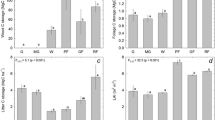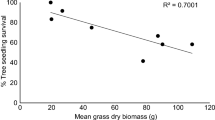Abstract
As with many grasslands globally, the Highveld grasslands of South Africa are tree-less, despite having a climate that can support tree growth. Models predict that fire maintains these grasslands. The question arises as to why fire-tolerant savanna trees do not survive in these ecosystems? Savanna tree survival in mesic areas is restricted by demographic bottlenecks, specifically limitations to sapling-escape from fire. It was hypothesised that ancient highly leached soils from grassland areas would prevent saplings from growing fast enough to escape the fire-trap. Growth rates of savanna tree seedlings (Acacia karroo Hayne and Acacia sieberiana Burtt Davy) were measured in a common garden experiment using soils from ten sites collected along a savanna-grassland continuum. Soils from grassland sites were relatively nutrient-poor compared to those from savannas with lower pH, and associated cations. A. sieberiana growth rates responded to pH and these nutrients, whereas A. karroo growth was less strongly linked to specific nutrients. Even so, both species accumulated more biomass when grown in soils from savanna sites compared to grassland sites. An exception was a low elevation low nutrient savanna site that resulted in poor growth, yet sustains high tree biomass in situ. Differences between growth in grassland and savanna soils were small. They may contribute to, but are unlikely to explain, the treeless nature of these grasslands.




Similar content being viewed by others
References
Acocks JPH (1953) Veld types of South Africa. Mem Bot Surv S Afr 28:1–192
Aranibar JN, Macko SA, Anderson IC, Potgieter ALF, Sowry R, Shugart HH (2003) Nutrient cycling responses to fire frequency in the Kruger National Park (South Africa) as indicated by stable isotope analysis. Isot Environ Health Stud 39:141–158
Barger NN, D’Antonio CM, Ghneim T, Brink K, Cuevas E (2002) Nutrient limitation to primary productivity in a secondary savanna in Venezuela. Biotropica 34:493–501
Behling H, Pillar VD, Muller SC, Overbeck GE (2007) Late-Holocene fire history in a forest-grassland mosaic in southern Brasil: implications for conservation. Appl Veg Sci 10:81–90
Benjamini Y, Hochberg Y (1995) Controlling the false discovery rate: a practical and powerful approach to multiple testing. J Roy Statis Soc, Ser B (Methodol) 57:289–300
Blackmore AC, Mentis MT, Scholes RJ (1990) The origin and extent of nutrient-enriched patches within a nutrient-poor savanna in South-Africa. J Biogeogr 17:463–470
Bond WJ (2008) What limits trees in C-4 grasslands and savannas? Ann Rev Ecol Evol Syst 39:641–659
Bond WJ, van Wilgen BW (1996) Fire and plants. Chapman & Hall, London
Bond WJ, Midgley GF, Woodward FI (2003) What controls South African vegetation—climate or fire? S Afr J Bot 69:79–91
Bond WJ, Silander JA, Ranaivonasy J, Ratsirarson J (2008) The antiquity of Madagascar’s grasslands and the rise of C-4 grassy biomes. J Biogeogr 35:1743–1758
Bragg TB, Hulbert LC (1976) Woody plant invasion of unburned Kansas Bluestem Prairie. J Range Manag 29:19–24
Bray RH, Kurtz LT (1945) Determination of total, organic, and available forms of phosphorus in soils. Soil Sci 59:39–45
Brejda JJ, Moorman TB, Karlen DL, Dao TH (2000) Identification of regional soil quality factors and indicators: I. Central and southern high plains. Soil Sci Soc Am J 64:2115–2124
Coates-Palgrave K (2002) Trees of southern Africa. Struik, Cape Town
Cox MS, Gerard PD, Wardlaw MC, Abshire MJ (2003) Variability of selected soil properties and their relationships with soybean yield. Soil Sci Soc Am J 67:1296–1302
Cramer MD, Chimphango SBM, van Cauter A, Waldram MS, Bond WJ (2007) Grass competition induces N-2 fixation in some species of African Acacia. J Ecol 95:1123–1133
Cramer MD, van Cauter A, Bond WJ (2009) Growth of N2-fixing African savanna Acacia species is constrained by below-ground competition with grass. J Ecol 98:156–167
Ehleringer JR, Rundel PW (1989) History, units and instrumentation. In: Rundel PW, Ehleringer JR, Nagy KA (eds) Stable Isotopes in ecological research. Ecological studies 68. Springer-Verlag, Berlin, pp 1–15
Ellery WN, Scholes RJ, Scholes MC (1995) The distribution of sweetveld and sourveld in South Africa’s grassland biome in relation to environmental factors. Afr J Range Forage Sci 12:38–45
Evans RD (2001) Physiological mechanisms influencing plant nitrogen isotope composition. Trends Plant Sci 6:121–126
Fairbanks DHK, Thompson MW, Vink DE, Newby TS, van den Berg HM, Everard DA (2000) The South African land-cover characteristics database: a synopsis of the landscape. S Afr J Sci 96:69–82
Fairfax RJ, Fensham RJ, Butler D, Quinn K, Sigley B, Holman J (2009) Effects of multiple fires on tree invasion in montane grasslands. Landsc Ecol 24:1363–1373
Fensham RJ, Fairfax RJ (1996) The disappearing grassy balds of the Bunya mountains, south-eastern Queensland. Aust J Bot 44:543–558
Fensham RJ, Fairfax RJ (2006) Can burning restrict eucalypt invasion on grassy balds? Austral Ecol 31:317–325
Fynn R, Haynes SRJ, O’Connor TG (2003) Burning causes long-term changes in soil organic matter content of a South African grassland. Soil Biol Biochem 35:677–687
Hartshorn AS, Coetsee C, Chadwick OA (2009) Pyromineralization of soil phosphorus in a South African savanna. Chem Geol 267:24–31
Higgins SI, Bond WJ, Trollope WSW (2000) Fire, resprouting and variability: a recipe for grass-tree coexistence in savanna. J Ecol 88:213–229
Hoffmann WA, Poorter H (2002) Avoiding bias in calculations of relative growth rate. Ann Bot 80:37–42
Hoffmann WA, Solbrig OT (2003) The role of topkill in the differential response of savanna woody species to fire. For Ecol Manag 180:273–286
Hunt R (1982) Plant growth curves: the functional approach to plant growth analysis. Arnold, London
King L (1978) The geomorphology of central and southern Africa. In: Werger MJA (ed) Biogeography and ecology of Southern Africa. Junk, The Hague, pp 3–18
Knapp AK, Blair JM, Briggs JM, Collins SL, Hartnett DC, Johnson LC, Towne EG (1999) The keystone role of bison in north American tallgrass prairie—Bison increase habitat heterogeneity and alter a broad array of plant, community, and ecosystem processes. Bioscience 49:39–50
Knoop WT, Walker BH (1985) Interactions of woody and herbaceous vegetation in a Southern African savanna. J Ecol 73:235–253
Kraaij T, Ward D (2006) Effects of rain, nitrogen, fire and grazing on tree recruitment and early survival in bush-encroached savanna, South Africa. Plant Ecol 186:235–246
Lambers H, Chapin FS, Pons TL (1998) Plant physiological ecology. Springer-Verlag, New York
Lewis OAM (1986) Plants and nitrogen. Edward Arnold Publishers Ltd, London
Lindsay MM, Bratton SP (1979) Vegetation of grassy balds and other high elevation disturbed areas in the Great-Smoky-Mountains-National-Park. Bull Torrey Bot Club 106:264–275
Mark AF (1958) The ecology of the southern Appalachian grass balds. Ecol Monogr 28:293–336
Meyer KM, Ward D, Moustakas A, Wiegand K (2005) Big is not better: small Acacia mellifera shrubs are more vital after fire. Afr J Ecol 43:131–136
Miller AJ, Cramer MD (2004) Root nitrogen acquisition and assimilation. Plant Soil 274:1–36
Mucina L, Rutherford MC (2006) The vegetation of South Africa, Lesotho and Swaziland. South African National Biodiversity Institute, Pretoria
O’Connor TG, Bredenkamp GJ (1997) Grassland. In: Cowling RM, Richardson DM, Pierce SM (eds) Vegetation of Southern Africa. Cambridge University Press, Cambridge, pp 215–257
O’Connor TG, Morris CD, Marriott DJ (2003) Change in land use and botanical composition of KwaZulu-Natal’s grasslands over the past fifty years: Acocks’ sites revisited. S Afr J Bot 69:105–115
Overbeck GE, Muller SC, Fidelis A, Pfadenhauer J, Pillar VD, Blanco CC, Boldrini II, Both R, Forneck ED (2007) Brazil’s neglected biome: the South Brazilian Campos. Perspect Plant Ecol Evol Syst 9:101–116
Partridge TC (1997) Evolution of landscapes. In: Cowling RM, Richardson DM, Pierce SM (eds) Vegetation of Southern Africa. Cambridge University Press, Cambridge, pp 5–20
Räsänen LA, Sprent JI, Lindström K (2001) Symbiotic properties of sinorhizobia isolated from Acacia and Prosopis nodules in Sudan and Senegal. Plant Soil 235:193–210
Richardson SJ, Peltzer DA, Allen RB, McGlone MS, Parfitt RL (2004) Rapid development of phosphorus limitation in temperate rainforest along the Franz Josef soil chronosequence. Oecologia 139:267–276
Robinson D (2001) Delta N-15 as an integrator of the nitrogen cycle. Trends Ecol Evol 16:153–162
Sankaran M, Hanan NP, Scholes RJ, Ratnam J, Augustine DJ, Cade BS, Gignoux J, Higgins SI, Le Roux X, Ludwig F, Ardo J, Banyikwa F, Bronn A, Bucini G, Caylor KK, Coughenour MB, Diouf A, Ekaya W, Feral CJ, February EC, Frost PGH, Hiernaux P, Hrabar H, Metzger KL, Prins HHT, Ringrose S, Sea W, Tews J, Worden J, Zambatis N (2005) Determinants of woody cover in African savannas. Nature 438:846–849
Scholes RJ (1990) The Influence of Soil Fertility on the Ecology of Southern African Dry Savannas. J Biogeogr 17:415–419
Scholes RJ, Archer SR (1997) Tree-grass interactions in savannas. Ann Rev Ecolog Syst 28:517–544
Schutz AEN, Bond WJ, Cramer MD (2009) Juggling carbon: allocation patterns of a dominant tree in a fire-prone savanna. Oecologia 160:235–246
Soil Classification Working Group (1991). Soil classification: a taxonomic system for South Africa. Department of Agricultural Development, Pretoria. In: Agricultural Research Council Institute for soil, climate and water. http://www.agis.agric.za/agisweb/?MIval=content2_h&id=Soil_class_key. Accessed 7 May 2010
Tchienkoua JM, Njomgang R, Nolte C, Sanginga N, Takow J (2008) Relationship of soil qualities to maize growth under increasing phosphorus supply in acid soils of southern Cameroon. Pedosphere 18:645–652
Trollope WSW (1984) Fire in Savanna. In: PdV B, Tainton NM (eds) Ecological effects of fire in South African ecosystems. Springer-Verlag, Berlin, pp 149–176
Vitousek PM, Chadwick OA, Crews TE, Fownes JH, Hendricks DM, Herbert DA (1997) Soil and ecosystem development across the Hawaiian islands. GSA Today 7:1–8
Walter H (1979) Vegetation of the earth and ecological systems of the geobiosphere. Springer-Verlag, New York
Weaver JE (1954) North American Prairie. Lincoln Press, New York
Webb LJ (1964) Historical interpretation of grass balds of Bunya Mountains South Queensland. Ecol 45:159–162
White F (1983) The vegetation of Africa. UNESCO, Paris
Williams RJ, Myers BA, Eamus D, Duff GA (1999) Reproductive phenology of woody species in a north Australian tropical savanna. Biotropica 31:626–636
Acknowledgements
The authors would like to thank Hans Lambers for suggesting this experiment, the staff of the Zululand Tree Project for field assistance, numerous farmers and landowners for use of their properties, Ian Newton (Department of Archaeometry, University of Cape Town) for mass spectrometer analysis, and William Stock (Edith Cowan University, Perth) for reviewing an earlier draft of the manuscript. Ezemvelo KZN Wildlife is thanked for hosting the project in Hluhluwe-iMfolozi Game Reserve. We are grateful for funding from the Mellon Foundation and National Research Foundation of South Africa.
Author information
Authors and Affiliations
Corresponding author
Additional information
Responsible Editor: Jeffrey Walck.
Electronic Supplementary Material
Below is the link to the electronic supplementary material.
ESM 1
Description of topsoil texture, subsoil and soil form, as well as elevation, mean annual precipitation and mean annual temperature at each site (DOC 33 kb)
ESM 2
Table of results of nutrient analyses for soils, collected from a range of elevations, used in the soil nutrient pot experiment (DOC 68 kb)
ESM 3
Table of results of a principal component analysis (PCA) of soil variables showing factor loadings on the first three components as well as Eigenvalues and the percentage variance explained by these components. Site principal component scores were correlated with elevation and the Pearson correlation coefficients with significance levels are shown for each principal component (DOC 55 kb)
Rights and permissions
About this article
Cite this article
Wakeling, J.L., Cramer, M.D. & Bond, W.J. Is the lack of leguminous savanna trees in grasslands of South Africa related to nutritional constraints?. Plant Soil 336, 173–182 (2010). https://doi.org/10.1007/s11104-010-0457-4
Received:
Accepted:
Published:
Issue Date:
DOI: https://doi.org/10.1007/s11104-010-0457-4




